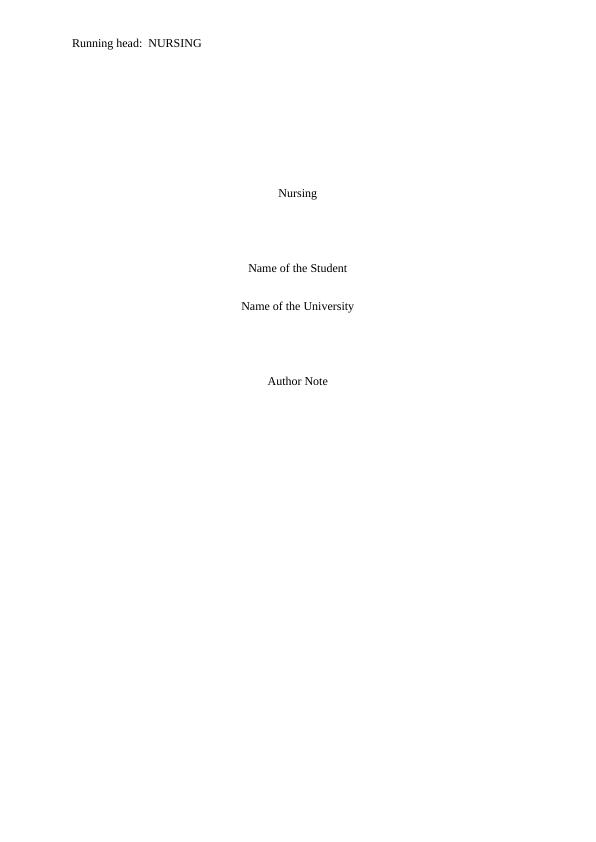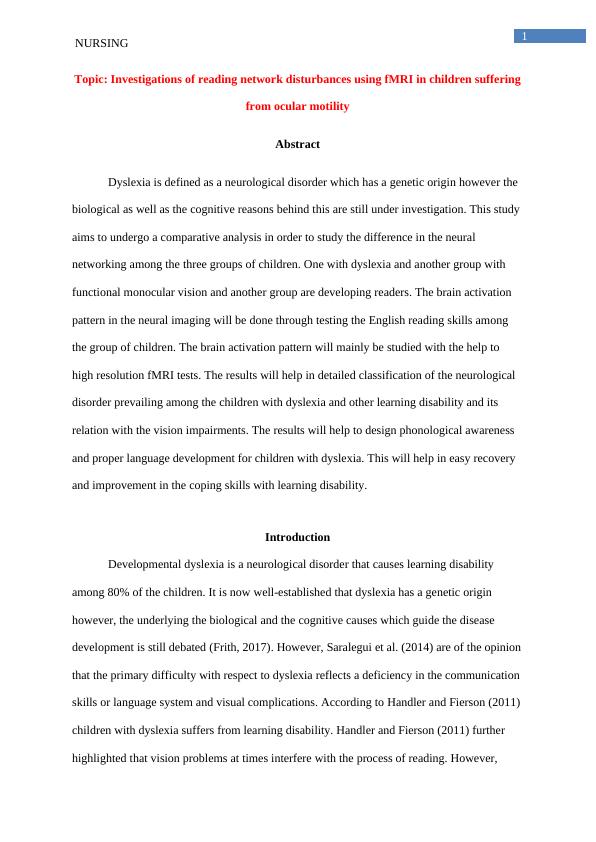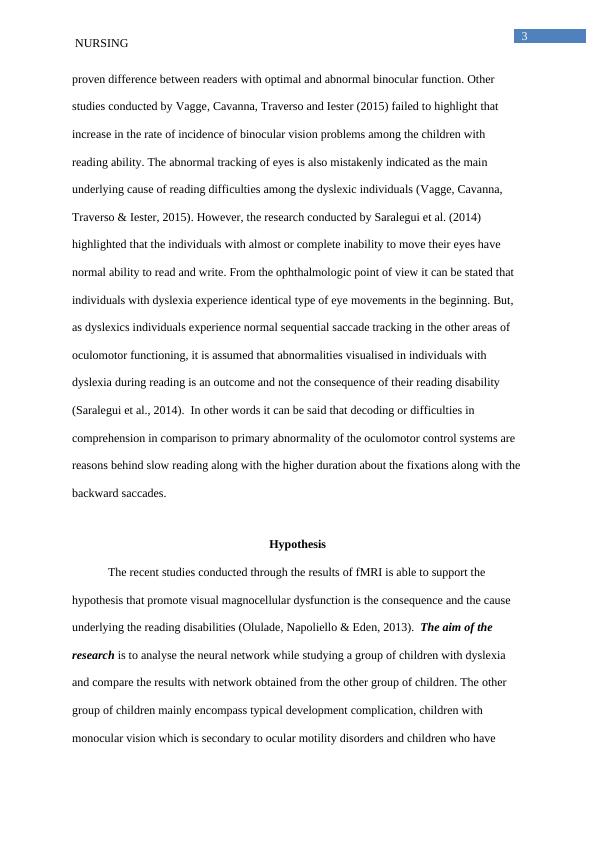Investigations of Reading Network Disturbances in Children with Dyslexia using fMRI
Added on 2023-05-30
13 Pages3428 Words479 Views
Running head: NURSING
Nursing
Name of the Student
Name of the University
Author Note
Nursing
Name of the Student
Name of the University
Author Note

1
NURSING
Topic: Investigations of reading network disturbances using fMRI in children suffering
from ocular motility
Abstract
Dyslexia is defined as a neurological disorder which has a genetic origin however the
biological as well as the cognitive reasons behind this are still under investigation. This study
aims to undergo a comparative analysis in order to study the difference in the neural
networking among the three groups of children. One with dyslexia and another group with
functional monocular vision and another group are developing readers. The brain activation
pattern in the neural imaging will be done through testing the English reading skills among
the group of children. The brain activation pattern will mainly be studied with the help to
high resolution fMRI tests. The results will help in detailed classification of the neurological
disorder prevailing among the children with dyslexia and other learning disability and its
relation with the vision impairments. The results will help to design phonological awareness
and proper language development for children with dyslexia. This will help in easy recovery
and improvement in the coping skills with learning disability.
Introduction
Developmental dyslexia is a neurological disorder that causes learning disability
among 80% of the children. It is now well-established that dyslexia has a genetic origin
however, the underlying the biological and the cognitive causes which guide the disease
development is still debated (Frith, 2017). However, Saralegui et al. (2014) are of the opinion
that the primary difficulty with respect to dyslexia reflects a deficiency in the communication
skills or language system and visual complications. According to Handler and Fierson (2011)
children with dyslexia suffers from learning disability. Handler and Fierson (2011) further
highlighted that vision problems at times interfere with the process of reading. However,
NURSING
Topic: Investigations of reading network disturbances using fMRI in children suffering
from ocular motility
Abstract
Dyslexia is defined as a neurological disorder which has a genetic origin however the
biological as well as the cognitive reasons behind this are still under investigation. This study
aims to undergo a comparative analysis in order to study the difference in the neural
networking among the three groups of children. One with dyslexia and another group with
functional monocular vision and another group are developing readers. The brain activation
pattern in the neural imaging will be done through testing the English reading skills among
the group of children. The brain activation pattern will mainly be studied with the help to
high resolution fMRI tests. The results will help in detailed classification of the neurological
disorder prevailing among the children with dyslexia and other learning disability and its
relation with the vision impairments. The results will help to design phonological awareness
and proper language development for children with dyslexia. This will help in easy recovery
and improvement in the coping skills with learning disability.
Introduction
Developmental dyslexia is a neurological disorder that causes learning disability
among 80% of the children. It is now well-established that dyslexia has a genetic origin
however, the underlying the biological and the cognitive causes which guide the disease
development is still debated (Frith, 2017). However, Saralegui et al. (2014) are of the opinion
that the primary difficulty with respect to dyslexia reflects a deficiency in the communication
skills or language system and visual complications. According to Handler and Fierson (2011)
children with dyslexia suffers from learning disability. Handler and Fierson (2011) further
highlighted that vision problems at times interfere with the process of reading. However,

2
NURSING
children with dyslexia or other children who are suffering from learning disability have
nearly identical visual functions and ocular health status as reflected among the children
without learning disability. Handler and Fierson (2011) highlighted that there is lack of
proper scientific evidence to support this view that subtle eye or visual problems can cause or
increase the severity of learning disability. Quercia, Feiss and Michel (2013) stated that
development dyslexia affects at-least 10% of school-aged children however, a detailed
etiology still remains unknown. One of the widely acknowledged theories in order to explain
the etiology of dyslexia is consistent presence of phonological difficulties in combination
with the inability to manipulate language sounds. Quercia, Feiss and Michel (2013) stated
that anomalies of visual attention along with short visual attention are demonstrated in a
number of cases. Spatial orientation is also affected among dyslexic who experiences a
preference towards spatial attention to the right. This asymmetry cause veritable neglect of
space on the left side. Advent of new explanatory theories further helps in the multimodal
explanation of the visual inputs in dyslexia.
Several theories have been proposed in order to explain the learning disability and
visual deficit associated with dyslexia. Some of these theories include auditory temporal
processing deficit theory, Cerebellar theory and more recently the attention span of visual
deficit theory and Magnocellular visual deficit theory of dyslexia. All these theories causes
deficiencies in cognitive and visual processing leading to learning disability and speech
problems (Saralegui et al., 2014). Rack (2017) proposed that the developmental dyslexia is a
heterogeneous impairment, which results from cognitive disorders that are independent in
nature. Here the majority of the individuals suffer from phonological deficit while other
develop visual deficit. Pammer (2014) stated that children with learning disabilities or
reading disorders have increased incidence of vision loss. Pammer (2014) highlighted that
importance of vision therapy for reading and learning disabilities. However, there is no
NURSING
children with dyslexia or other children who are suffering from learning disability have
nearly identical visual functions and ocular health status as reflected among the children
without learning disability. Handler and Fierson (2011) highlighted that there is lack of
proper scientific evidence to support this view that subtle eye or visual problems can cause or
increase the severity of learning disability. Quercia, Feiss and Michel (2013) stated that
development dyslexia affects at-least 10% of school-aged children however, a detailed
etiology still remains unknown. One of the widely acknowledged theories in order to explain
the etiology of dyslexia is consistent presence of phonological difficulties in combination
with the inability to manipulate language sounds. Quercia, Feiss and Michel (2013) stated
that anomalies of visual attention along with short visual attention are demonstrated in a
number of cases. Spatial orientation is also affected among dyslexic who experiences a
preference towards spatial attention to the right. This asymmetry cause veritable neglect of
space on the left side. Advent of new explanatory theories further helps in the multimodal
explanation of the visual inputs in dyslexia.
Several theories have been proposed in order to explain the learning disability and
visual deficit associated with dyslexia. Some of these theories include auditory temporal
processing deficit theory, Cerebellar theory and more recently the attention span of visual
deficit theory and Magnocellular visual deficit theory of dyslexia. All these theories causes
deficiencies in cognitive and visual processing leading to learning disability and speech
problems (Saralegui et al., 2014). Rack (2017) proposed that the developmental dyslexia is a
heterogeneous impairment, which results from cognitive disorders that are independent in
nature. Here the majority of the individuals suffer from phonological deficit while other
develop visual deficit. Pammer (2014) stated that children with learning disabilities or
reading disorders have increased incidence of vision loss. Pammer (2014) highlighted that
importance of vision therapy for reading and learning disabilities. However, there is no

3
NURSING
proven difference between readers with optimal and abnormal binocular function. Other
studies conducted by Vagge, Cavanna, Traverso and Iester (2015) failed to highlight that
increase in the rate of incidence of binocular vision problems among the children with
reading ability. The abnormal tracking of eyes is also mistakenly indicated as the main
underlying cause of reading difficulties among the dyslexic individuals (Vagge, Cavanna,
Traverso & Iester, 2015). However, the research conducted by Saralegui et al. (2014)
highlighted that the individuals with almost or complete inability to move their eyes have
normal ability to read and write. From the ophthalmologic point of view it can be stated that
individuals with dyslexia experience identical type of eye movements in the beginning. But,
as dyslexics individuals experience normal sequential saccade tracking in the other areas of
oculomotor functioning, it is assumed that abnormalities visualised in individuals with
dyslexia during reading is an outcome and not the consequence of their reading disability
(Saralegui et al., 2014). In other words it can be said that decoding or difficulties in
comprehension in comparison to primary abnormality of the oculomotor control systems are
reasons behind slow reading along with the higher duration about the fixations along with the
backward saccades.
Hypothesis
The recent studies conducted through the results of fMRI is able to support the
hypothesis that promote visual magnocellular dysfunction is the consequence and the cause
underlying the reading disabilities (Olulade, Napoliello & Eden, 2013). The aim of the
research is to analyse the neural network while studying a group of children with dyslexia
and compare the results with network obtained from the other group of children. The other
group of children mainly encompass typical development complication, children with
monocular vision which is secondary to ocular motility disorders and children who have
NURSING
proven difference between readers with optimal and abnormal binocular function. Other
studies conducted by Vagge, Cavanna, Traverso and Iester (2015) failed to highlight that
increase in the rate of incidence of binocular vision problems among the children with
reading ability. The abnormal tracking of eyes is also mistakenly indicated as the main
underlying cause of reading difficulties among the dyslexic individuals (Vagge, Cavanna,
Traverso & Iester, 2015). However, the research conducted by Saralegui et al. (2014)
highlighted that the individuals with almost or complete inability to move their eyes have
normal ability to read and write. From the ophthalmologic point of view it can be stated that
individuals with dyslexia experience identical type of eye movements in the beginning. But,
as dyslexics individuals experience normal sequential saccade tracking in the other areas of
oculomotor functioning, it is assumed that abnormalities visualised in individuals with
dyslexia during reading is an outcome and not the consequence of their reading disability
(Saralegui et al., 2014). In other words it can be said that decoding or difficulties in
comprehension in comparison to primary abnormality of the oculomotor control systems are
reasons behind slow reading along with the higher duration about the fixations along with the
backward saccades.
Hypothesis
The recent studies conducted through the results of fMRI is able to support the
hypothesis that promote visual magnocellular dysfunction is the consequence and the cause
underlying the reading disabilities (Olulade, Napoliello & Eden, 2013). The aim of the
research is to analyse the neural network while studying a group of children with dyslexia
and compare the results with network obtained from the other group of children. The other
group of children mainly encompass typical development complication, children with
monocular vision which is secondary to ocular motility disorders and children who have

End of preview
Want to access all the pages? Upload your documents or become a member.
Related Documents
Effectiveness of Instructional Activities for Improving Reading Skills of Dyslexic Studentslg...
|7
|1488
|455
